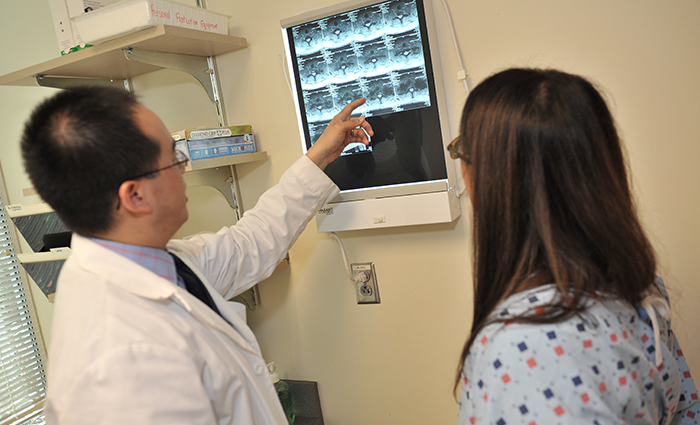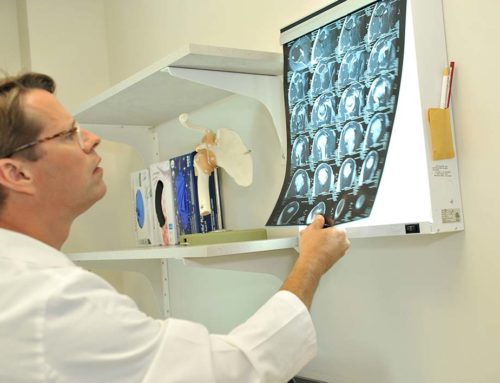Few challenges are as life-altering as unrelenting, chronic pain. Trying to manage life’s demands while enduring daily bone and joint pain is both physically and mentally exhausting. Many people find the quest for pain relief stressful because of the lack of understanding of those around them and the disappointment of yet another ineffective treatment.
Take heart. There is hope in working with medical professionals who are specially equipped to help those facing chronic orthopaedic pain. Learn about the possibilities found in the growing field of physiatry, and find out if seeking treatment from a physiatrist is right for you.
What is physiatry?
Physiatry is a relatively new branch of physical medicine centered on rehabilitation. This specialty was developed after World World II from advancements in the treatment of soldiers.
This promising field is based on the diagnosis, treatment and management of the causes of chronic pain through minimally-invasive pain relief options. Physiatrists specialize in an array of treatments for the musculoskeletal system without surgery. This treatment focuses on the patient becoming as pain-free and functional as possible for a productive and enjoyable life.
Physiatrists have a focused understanding of how the body works and medical issues affecting mobility, mental state and quality of life. They are well-trained at using diagnostic tools for detecting bone, muscle and nerve damage.
The primary focuses of orthopaedic physiatry are:
- Treatment of the spine
- Back pain, such as sciatica
- Muscle and ligament injuries
- Myofascial pain
- Osteoporosis
- Spinal cord injuries
Yet, physiatrists approach the overall needs of the patient, not just focusing on a specific injury or condition. This approach increases the possibility of sustained recovery and the prevention of ongoing pain or sources of dysfunction. The aim is to restore patients’ normal functions and improve the emotional, physical, vocational and psychosocial perspectives.
What are the benefits of physiatry for chronic pain?
Because physiatry is grounded in a deep understanding of the complexity and inner workings of body systems, there exists a vast array of benefits and applications.
A diagnosis is made through the completion of a detailed medical history, including questions about past approaches to treatment and beliefs about pain control. A complete physical exam is an integral part of the treatment, including X-rays and magnetic resonance imaging (MRI) scans. This comprehensive approach allows the physiatrist to receive a holistic look at the patient’s needs and help pin-point difficult to diagnose pain.
Treatments are multi-faceted, including exercise, occupational and recreational therapy, massage therapy, and health psychology. Assistive devices such as back braces and walkers are skillfully selected and included in an individualized plan.
These medical doctors counsel patients on healthy practices, including stopping smoking, maintaining a healthy weight and sound nutritional choices. They are equipped with the knowledge to prescribe a medication regimen when necessary.
As specialists in rehabilitation, therapy is an integral part of most physiatrists’ practices. There is a focus on physical therapy and healthy activity to help the patient return to and maintain a functional and enjoyable life. Physicians specializing in physiatry use orthopaedic pain treatments to help bring severe pain under control so rehabilitation can take place.
Specific treatment may include:
- Electromyography (EMG): Inserting fine needle electrodes into muscles to measure the performance of muscles and nerves and discern weaknesses.
- Nerve conduction studies (NCS): Using electrodes to determine the location of nervous system injuries.
- Peripheral joint injection therapy: Injecting bone and soft tissues to diagnose and treat disorders.
- Trigger point injections: Using lidocaine or dry-needling on trigger points to ease soft tissue pain.
- Musculoskeletal ultrasound: Utilizing ultrasound to evaluate soft tissue abnormalities and guide injections.
While some in the medical field may consider physiatry as a separate, specialized field, others are coming to see the benefit of this comprehensive approach in coordinating a patient’s entire care. Physiatrists offer insights into the “big picture” and provide guidance to a full-spectrum of treatment options. Physiatrists are now vital members of many orthopaedic teams in inpatient rehabilitation facilities outpatient clinics. These specialists can refer and coordinate psychosocial support and refer to alternative therapies, such as medical acupuncture. Surgical specialists are referred to as needed.
Physiatrists in Raleigh
Chronic bone and joint pain should not rule your life. Physiatry may offer you the relief you deserve. If you are ready to find a compassionate, comprehensive approach to maximize your pain care, consider the possibility of adding a physiatrist to your team. The orthopaedic physiatry team at Cary Orthopaedics is well-versed in managing pain with the least invasive approach. Contact us today to learn how you can have a pain-free life.






